HRM in Banking & Real Estate: JP Morgan, Canary Wharf Analysis
VerifiedAdded on 2020/11/12
|19
|5538
|315
Report
AI Summary
This report provides an in-depth analysis of Human Resource Management (HRM) practices within the context of JP Morgan and Canary Wharf. The report begins by defining HRM, its purpose, and functions, including workforce planning and resourcing, strategic HRM, and the distinction between hard and soft HRM approaches. It then explores the strengths and weaknesses of various recruitment and selection methods, such as internal and external recruitment, highlighting their implications for both employers and employees. The report further examines the benefits of different HRM practices, including training and development, rewards and recognitions, and career management, for both employers and employees. Finally, it discusses the role of HRM practices in raising organizational profit and productivity, emphasizing the importance of an effective workforce and strategic implementation of HRM strategies.
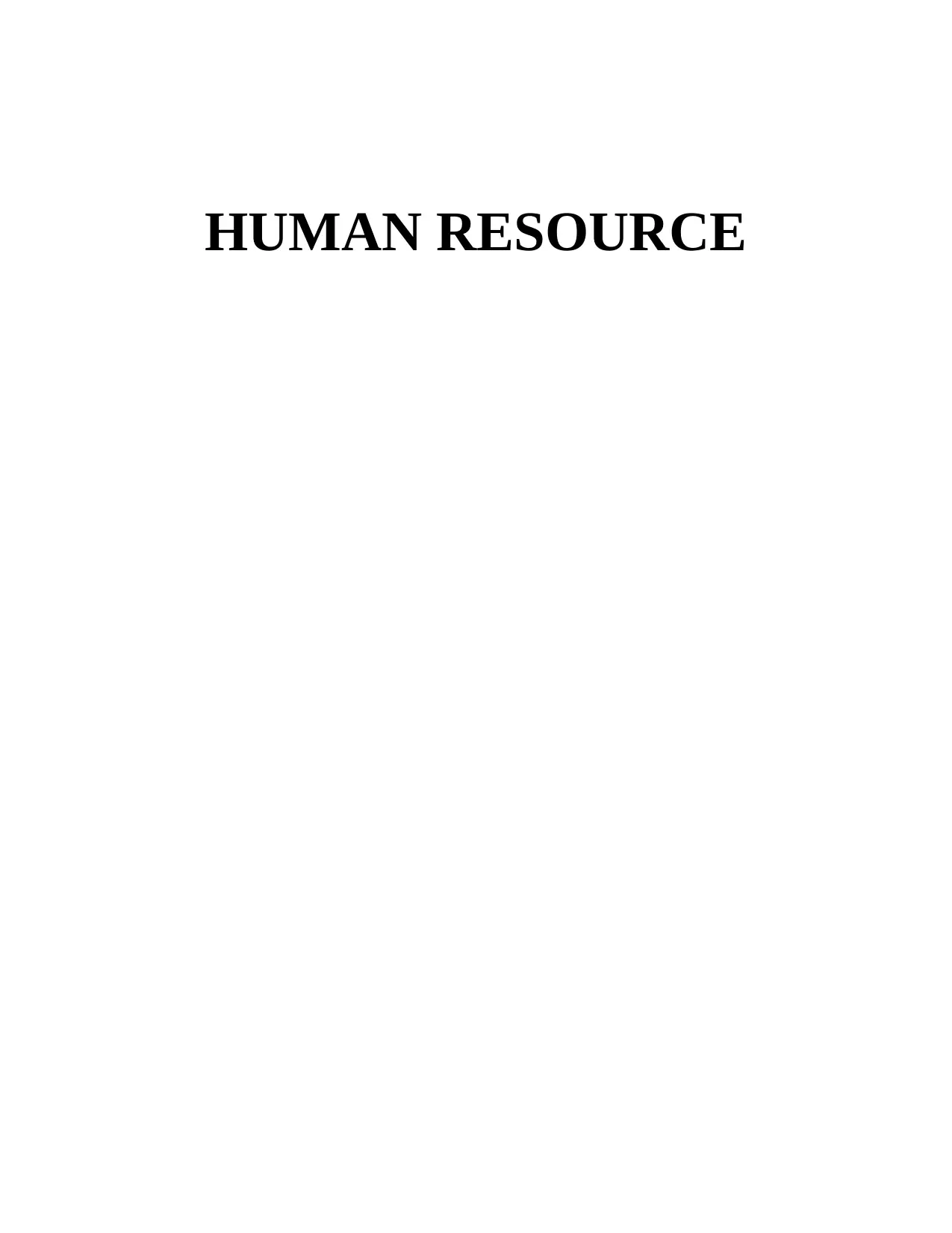
HUMAN RESOURCE
Paraphrase This Document
Need a fresh take? Get an instant paraphrase of this document with our AI Paraphraser
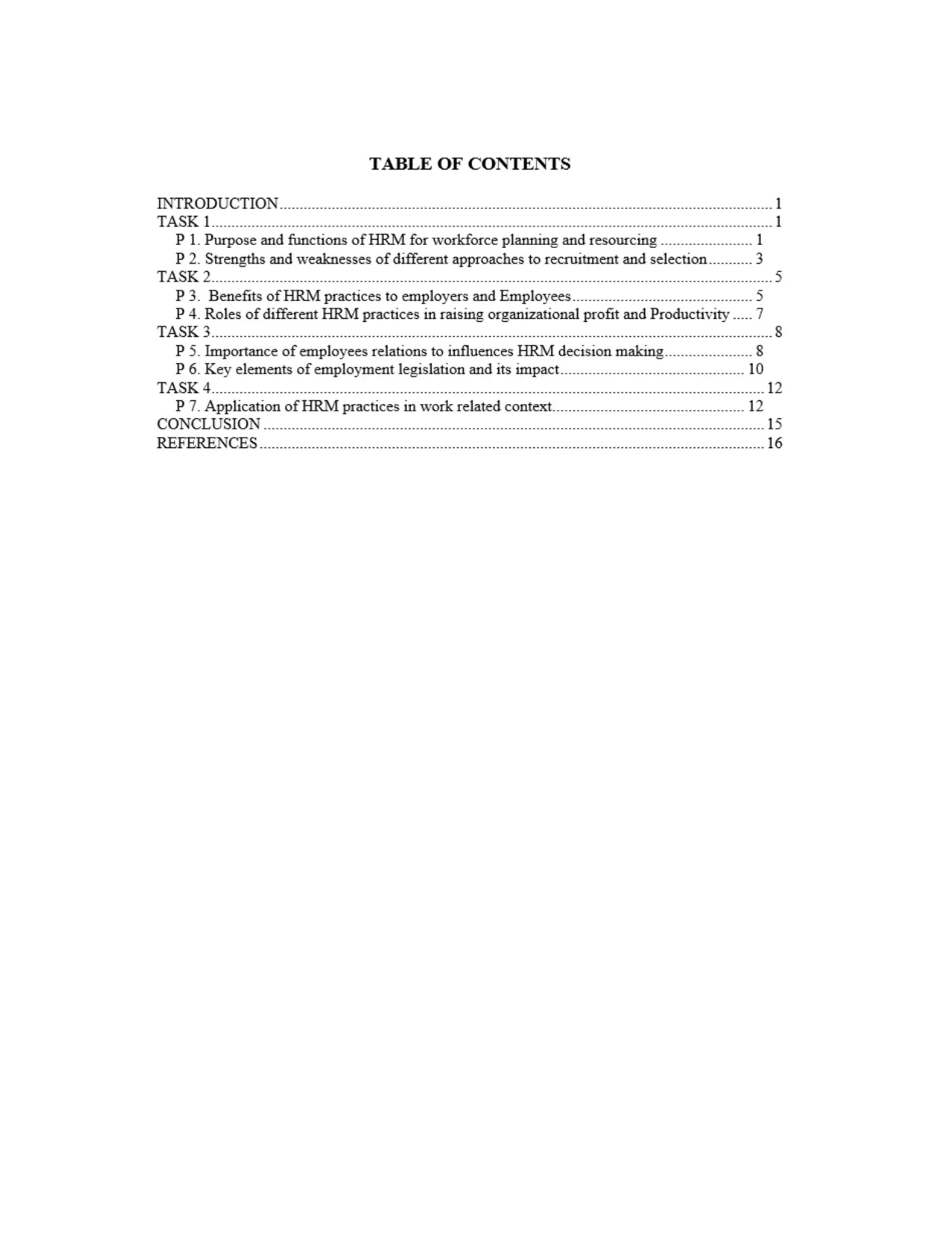
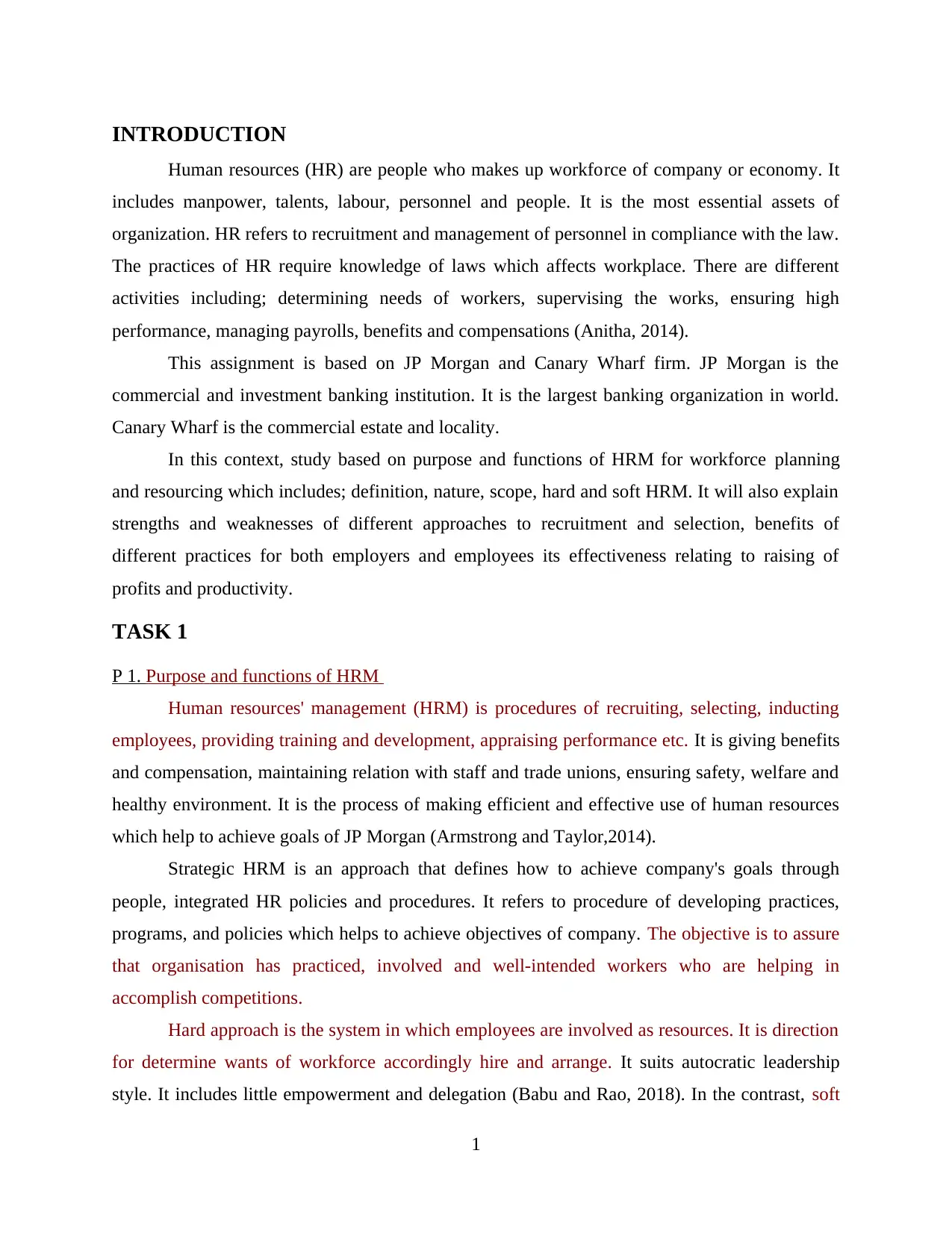
INTRODUCTION
Human resources (HR) are people who makes up workforce of company or economy. It
includes manpower, talents, labour, personnel and people. It is the most essential assets of
organization. HR refers to recruitment and management of personnel in compliance with the law.
The practices of HR require knowledge of laws which affects workplace. There are different
activities including; determining needs of workers, supervising the works, ensuring high
performance, managing payrolls, benefits and compensations (Anitha, 2014).
This assignment is based on JP Morgan and Canary Wharf firm. JP Morgan is the
commercial and investment banking institution. It is the largest banking organization in world.
Canary Wharf is the commercial estate and locality.
In this context, study based on purpose and functions of HRM for workforce planning
and resourcing which includes; definition, nature, scope, hard and soft HRM. It will also explain
strengths and weaknesses of different approaches to recruitment and selection, benefits of
different practices for both employers and employees its effectiveness relating to raising of
profits and productivity.
TASK 1
P 1. Purpose and functions of HRM
Human resources' management (HRM) is procedures of recruiting, selecting, inducting
employees, providing training and development, appraising performance etc. It is giving benefits
and compensation, maintaining relation with staff and trade unions, ensuring safety, welfare and
healthy environment. It is the process of making efficient and effective use of human resources
which help to achieve goals of JP Morgan (Armstrong and Taylor,2014).
Strategic HRM is an approach that defines how to achieve company's goals through
people, integrated HR policies and procedures. It refers to procedure of developing practices,
programs, and policies which helps to achieve objectives of company. The objective is to assure
that organisation has practiced, involved and well-intended workers who are helping in
accomplish competitions.
Hard approach is the system in which employees are involved as resources. It is direction
for determine wants of workforce accordingly hire and arrange. It suits autocratic leadership
style. It includes little empowerment and delegation (Babu and Rao, 2018). In the contrast, soft
1
Human resources (HR) are people who makes up workforce of company or economy. It
includes manpower, talents, labour, personnel and people. It is the most essential assets of
organization. HR refers to recruitment and management of personnel in compliance with the law.
The practices of HR require knowledge of laws which affects workplace. There are different
activities including; determining needs of workers, supervising the works, ensuring high
performance, managing payrolls, benefits and compensations (Anitha, 2014).
This assignment is based on JP Morgan and Canary Wharf firm. JP Morgan is the
commercial and investment banking institution. It is the largest banking organization in world.
Canary Wharf is the commercial estate and locality.
In this context, study based on purpose and functions of HRM for workforce planning
and resourcing which includes; definition, nature, scope, hard and soft HRM. It will also explain
strengths and weaknesses of different approaches to recruitment and selection, benefits of
different practices for both employers and employees its effectiveness relating to raising of
profits and productivity.
TASK 1
P 1. Purpose and functions of HRM
Human resources' management (HRM) is procedures of recruiting, selecting, inducting
employees, providing training and development, appraising performance etc. It is giving benefits
and compensation, maintaining relation with staff and trade unions, ensuring safety, welfare and
healthy environment. It is the process of making efficient and effective use of human resources
which help to achieve goals of JP Morgan (Armstrong and Taylor,2014).
Strategic HRM is an approach that defines how to achieve company's goals through
people, integrated HR policies and procedures. It refers to procedure of developing practices,
programs, and policies which helps to achieve objectives of company. The objective is to assure
that organisation has practiced, involved and well-intended workers who are helping in
accomplish competitions.
Hard approach is the system in which employees are involved as resources. It is direction
for determine wants of workforce accordingly hire and arrange. It suits autocratic leadership
style. It includes little empowerment and delegation (Babu and Rao, 2018). In the contrast, soft
1
⊘ This is a preview!⊘
Do you want full access?
Subscribe today to unlock all pages.

Trusted by 1+ million students worldwide
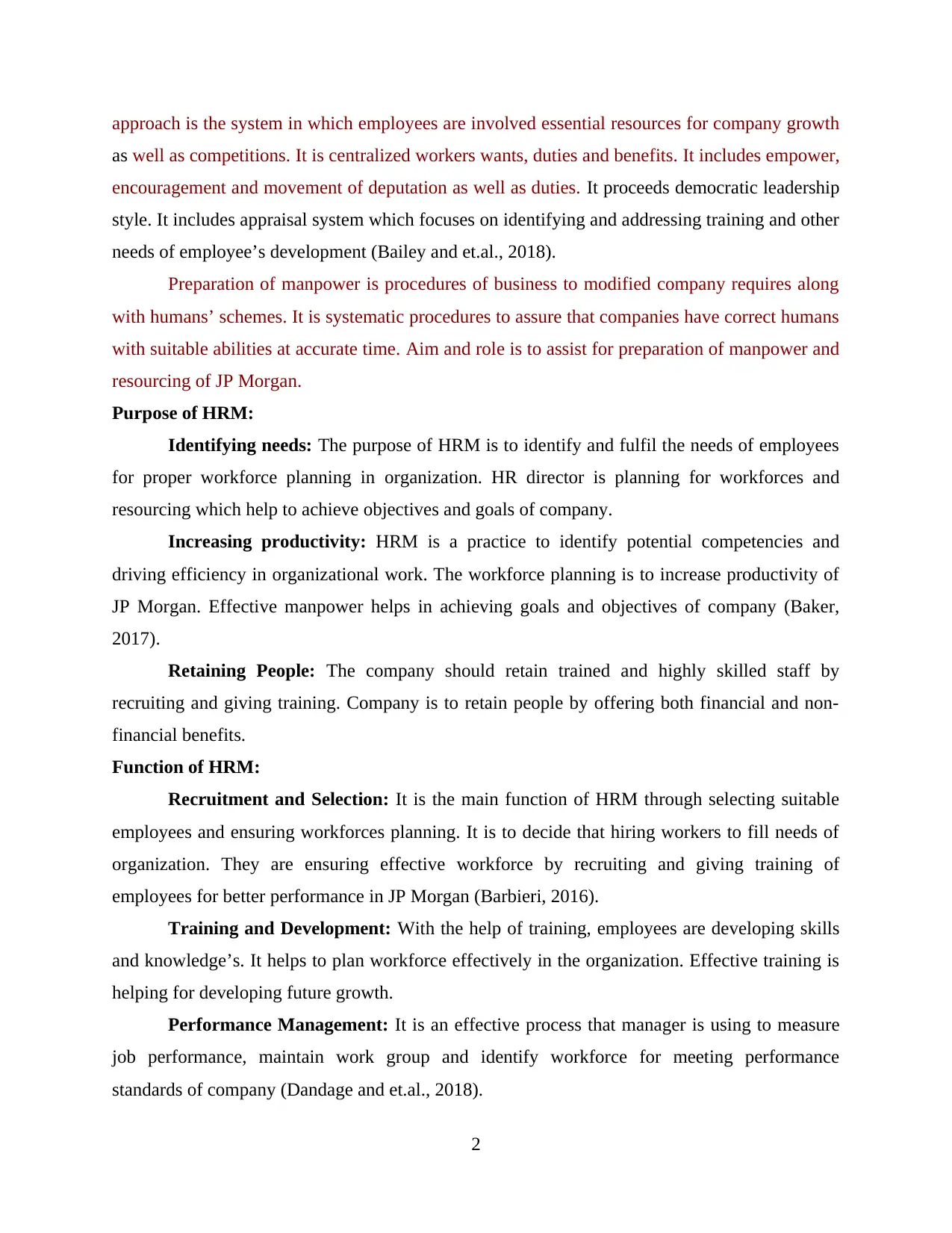
approach is the system in which employees are involved essential resources for company growth
as well as competitions. It is centralized workers wants, duties and benefits. It includes empower,
encouragement and movement of deputation as well as duties. It proceeds democratic leadership
style. It includes appraisal system which focuses on identifying and addressing training and other
needs of employee’s development (Bailey and et.al., 2018).
Preparation of manpower is procedures of business to modified company requires along
with humans’ schemes. It is systematic procedures to assure that companies have correct humans
with suitable abilities at accurate time. Aim and role is to assist for preparation of manpower and
resourcing of JP Morgan.
Purpose of HRM:
Identifying needs: The purpose of HRM is to identify and fulfil the needs of employees
for proper workforce planning in organization. HR director is planning for workforces and
resourcing which help to achieve objectives and goals of company.
Increasing productivity: HRM is a practice to identify potential competencies and
driving efficiency in organizational work. The workforce planning is to increase productivity of
JP Morgan. Effective manpower helps in achieving goals and objectives of company (Baker,
2017).
Retaining People: The company should retain trained and highly skilled staff by
recruiting and giving training. Company is to retain people by offering both financial and non-
financial benefits.
Function of HRM:
Recruitment and Selection: It is the main function of HRM through selecting suitable
employees and ensuring workforces planning. It is to decide that hiring workers to fill needs of
organization. They are ensuring effective workforce by recruiting and giving training of
employees for better performance in JP Morgan (Barbieri, 2016).
Training and Development: With the help of training, employees are developing skills
and knowledge’s. It helps to plan workforce effectively in the organization. Effective training is
helping for developing future growth.
Performance Management: It is an effective process that manager is using to measure
job performance, maintain work group and identify workforce for meeting performance
standards of company (Dandage and et.al., 2018).
2
as well as competitions. It is centralized workers wants, duties and benefits. It includes empower,
encouragement and movement of deputation as well as duties. It proceeds democratic leadership
style. It includes appraisal system which focuses on identifying and addressing training and other
needs of employee’s development (Bailey and et.al., 2018).
Preparation of manpower is procedures of business to modified company requires along
with humans’ schemes. It is systematic procedures to assure that companies have correct humans
with suitable abilities at accurate time. Aim and role is to assist for preparation of manpower and
resourcing of JP Morgan.
Purpose of HRM:
Identifying needs: The purpose of HRM is to identify and fulfil the needs of employees
for proper workforce planning in organization. HR director is planning for workforces and
resourcing which help to achieve objectives and goals of company.
Increasing productivity: HRM is a practice to identify potential competencies and
driving efficiency in organizational work. The workforce planning is to increase productivity of
JP Morgan. Effective manpower helps in achieving goals and objectives of company (Baker,
2017).
Retaining People: The company should retain trained and highly skilled staff by
recruiting and giving training. Company is to retain people by offering both financial and non-
financial benefits.
Function of HRM:
Recruitment and Selection: It is the main function of HRM through selecting suitable
employees and ensuring workforces planning. It is to decide that hiring workers to fill needs of
organization. They are ensuring effective workforce by recruiting and giving training of
employees for better performance in JP Morgan (Barbieri, 2016).
Training and Development: With the help of training, employees are developing skills
and knowledge’s. It helps to plan workforce effectively in the organization. Effective training is
helping for developing future growth.
Performance Management: It is an effective process that manager is using to measure
job performance, maintain work group and identify workforce for meeting performance
standards of company (Dandage and et.al., 2018).
2
Paraphrase This Document
Need a fresh take? Get an instant paraphrase of this document with our AI Paraphraser
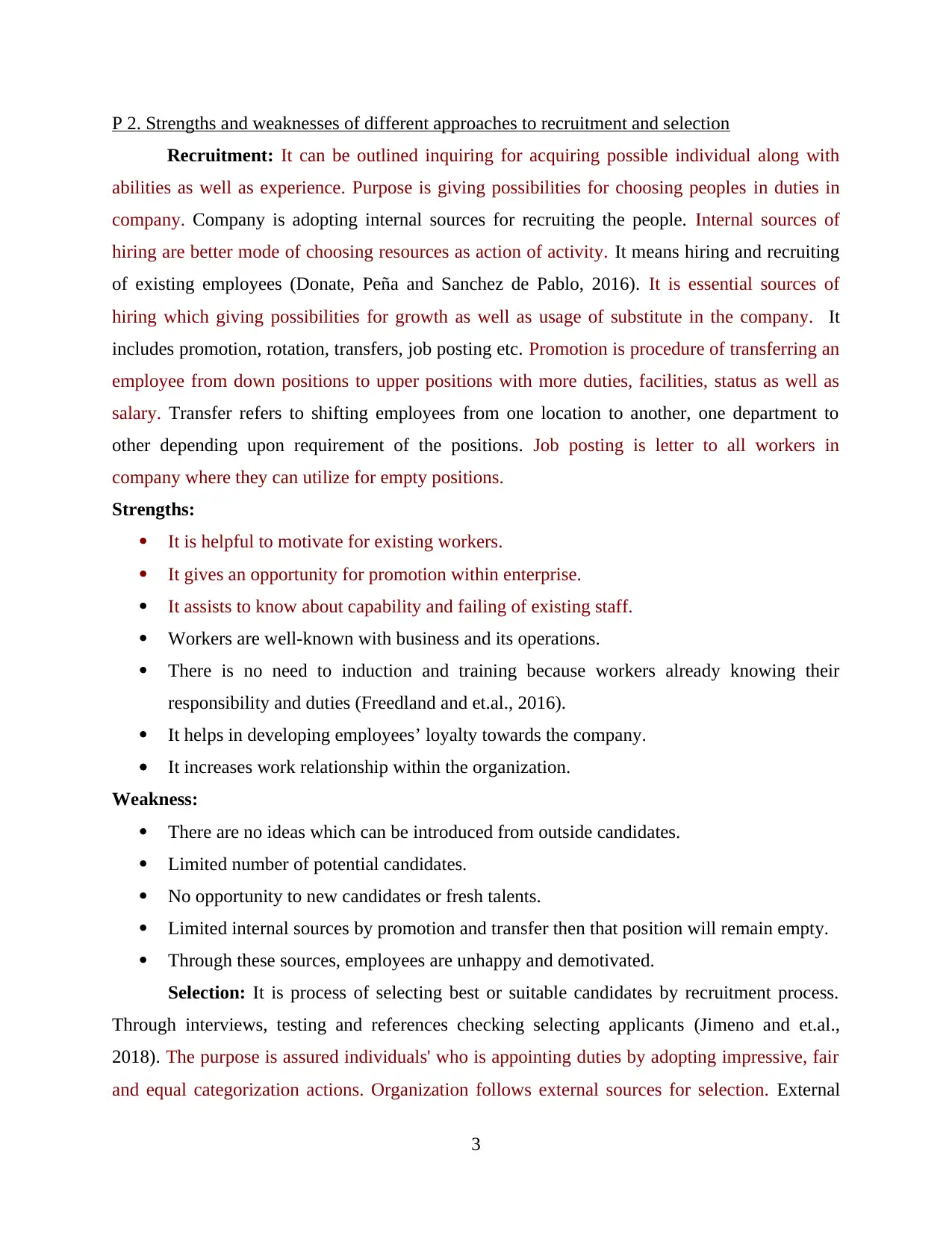
P 2. Strengths and weaknesses of different approaches to recruitment and selection
Recruitment: It can be outlined inquiring for acquiring possible individual along with
abilities as well as experience. Purpose is giving possibilities for choosing peoples in duties in
company. Company is adopting internal sources for recruiting the people. Internal sources of
hiring are better mode of choosing resources as action of activity. It means hiring and recruiting
of existing employees (Donate, Peña and Sanchez de Pablo, 2016). It is essential sources of
hiring which giving possibilities for growth as well as usage of substitute in the company. It
includes promotion, rotation, transfers, job posting etc. Promotion is procedure of transferring an
employee from down positions to upper positions with more duties, facilities, status as well as
salary. Transfer refers to shifting employees from one location to another, one department to
other depending upon requirement of the positions. Job posting is letter to all workers in
company where they can utilize for empty positions.
Strengths:
It is helpful to motivate for existing workers.
It gives an opportunity for promotion within enterprise.
It assists to know about capability and failing of existing staff.
Workers are well-known with business and its operations.
There is no need to induction and training because workers already knowing their
responsibility and duties (Freedland and et.al., 2016).
It helps in developing employees’ loyalty towards the company.
It increases work relationship within the organization.
Weakness:
There are no ideas which can be introduced from outside candidates.
Limited number of potential candidates.
No opportunity to new candidates or fresh talents.
Limited internal sources by promotion and transfer then that position will remain empty.
Through these sources, employees are unhappy and demotivated.
Selection: It is process of selecting best or suitable candidates by recruitment process.
Through interviews, testing and references checking selecting applicants (Jimeno and et.al.,
2018). The purpose is assured individuals' who is appointing duties by adopting impressive, fair
and equal categorization actions. Organization follows external sources for selection. External
3
Recruitment: It can be outlined inquiring for acquiring possible individual along with
abilities as well as experience. Purpose is giving possibilities for choosing peoples in duties in
company. Company is adopting internal sources for recruiting the people. Internal sources of
hiring are better mode of choosing resources as action of activity. It means hiring and recruiting
of existing employees (Donate, Peña and Sanchez de Pablo, 2016). It is essential sources of
hiring which giving possibilities for growth as well as usage of substitute in the company. It
includes promotion, rotation, transfers, job posting etc. Promotion is procedure of transferring an
employee from down positions to upper positions with more duties, facilities, status as well as
salary. Transfer refers to shifting employees from one location to another, one department to
other depending upon requirement of the positions. Job posting is letter to all workers in
company where they can utilize for empty positions.
Strengths:
It is helpful to motivate for existing workers.
It gives an opportunity for promotion within enterprise.
It assists to know about capability and failing of existing staff.
Workers are well-known with business and its operations.
There is no need to induction and training because workers already knowing their
responsibility and duties (Freedland and et.al., 2016).
It helps in developing employees’ loyalty towards the company.
It increases work relationship within the organization.
Weakness:
There are no ideas which can be introduced from outside candidates.
Limited number of potential candidates.
No opportunity to new candidates or fresh talents.
Limited internal sources by promotion and transfer then that position will remain empty.
Through these sources, employees are unhappy and demotivated.
Selection: It is process of selecting best or suitable candidates by recruitment process.
Through interviews, testing and references checking selecting applicants (Jimeno and et.al.,
2018). The purpose is assured individuals' who is appointing duties by adopting impressive, fair
and equal categorization actions. Organization follows external sources for selection. External
3
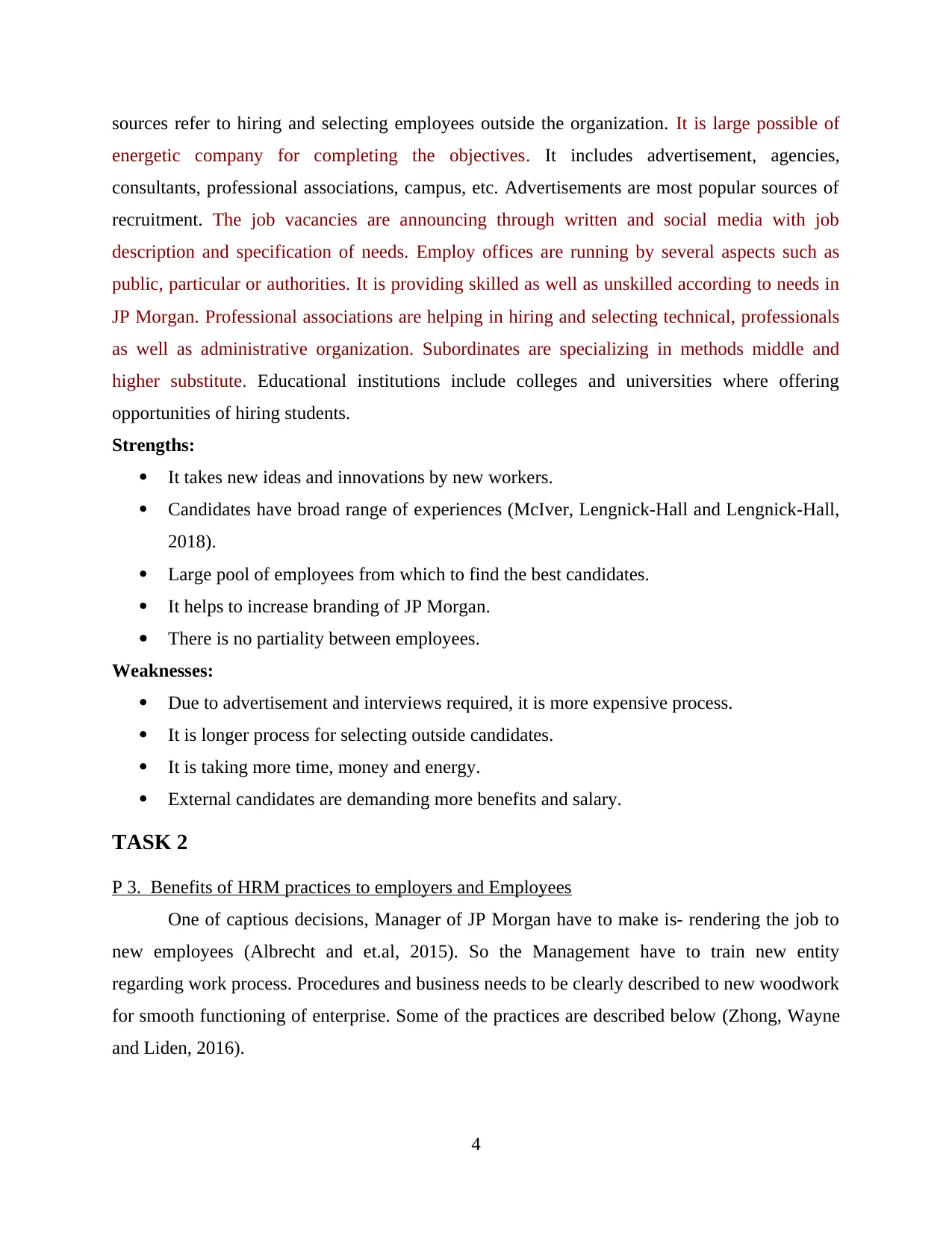
sources refer to hiring and selecting employees outside the organization. It is large possible of
energetic company for completing the objectives. It includes advertisement, agencies,
consultants, professional associations, campus, etc. Advertisements are most popular sources of
recruitment. The job vacancies are announcing through written and social media with job
description and specification of needs. Employ offices are running by several aspects such as
public, particular or authorities. It is providing skilled as well as unskilled according to needs in
JP Morgan. Professional associations are helping in hiring and selecting technical, professionals
as well as administrative organization. Subordinates are specializing in methods middle and
higher substitute. Educational institutions include colleges and universities where offering
opportunities of hiring students.
Strengths:
It takes new ideas and innovations by new workers.
Candidates have broad range of experiences (McIver, Lengnick-Hall and Lengnick-Hall,
2018).
Large pool of employees from which to find the best candidates.
It helps to increase branding of JP Morgan.
There is no partiality between employees.
Weaknesses:
Due to advertisement and interviews required, it is more expensive process.
It is longer process for selecting outside candidates.
It is taking more time, money and energy.
External candidates are demanding more benefits and salary.
TASK 2
P 3. Benefits of HRM practices to employers and Employees
One of captious decisions, Manager of JP Morgan have to make is- rendering the job to
new employees (Albrecht and et.al, 2015). So the Management have to train new entity
regarding work process. Procedures and business needs to be clearly described to new woodwork
for smooth functioning of enterprise. Some of the practices are described below (Zhong, Wayne
and Liden, 2016).
4
energetic company for completing the objectives. It includes advertisement, agencies,
consultants, professional associations, campus, etc. Advertisements are most popular sources of
recruitment. The job vacancies are announcing through written and social media with job
description and specification of needs. Employ offices are running by several aspects such as
public, particular or authorities. It is providing skilled as well as unskilled according to needs in
JP Morgan. Professional associations are helping in hiring and selecting technical, professionals
as well as administrative organization. Subordinates are specializing in methods middle and
higher substitute. Educational institutions include colleges and universities where offering
opportunities of hiring students.
Strengths:
It takes new ideas and innovations by new workers.
Candidates have broad range of experiences (McIver, Lengnick-Hall and Lengnick-Hall,
2018).
Large pool of employees from which to find the best candidates.
It helps to increase branding of JP Morgan.
There is no partiality between employees.
Weaknesses:
Due to advertisement and interviews required, it is more expensive process.
It is longer process for selecting outside candidates.
It is taking more time, money and energy.
External candidates are demanding more benefits and salary.
TASK 2
P 3. Benefits of HRM practices to employers and Employees
One of captious decisions, Manager of JP Morgan have to make is- rendering the job to
new employees (Albrecht and et.al, 2015). So the Management have to train new entity
regarding work process. Procedures and business needs to be clearly described to new woodwork
for smooth functioning of enterprise. Some of the practices are described below (Zhong, Wayne
and Liden, 2016).
4
⊘ This is a preview!⊘
Do you want full access?
Subscribe today to unlock all pages.

Trusted by 1+ million students worldwide
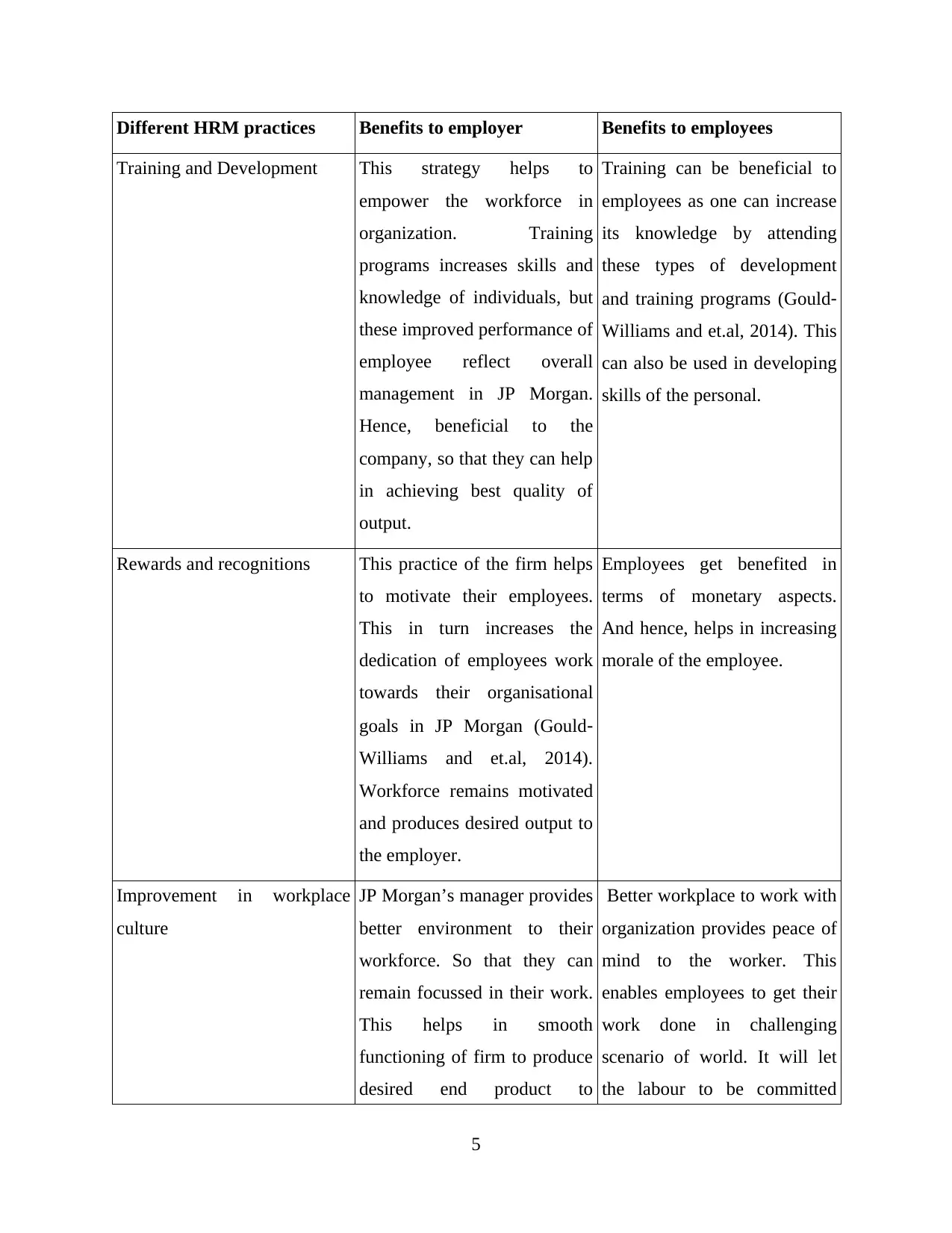
Different HRM practices Benefits to employer Benefits to employees
Training and Development This strategy helps to
empower the workforce in
organization. Training
programs increases skills and
knowledge of individuals, but
these improved performance of
employee reflect overall
management in JP Morgan.
Hence, beneficial to the
company, so that they can help
in achieving best quality of
output.
Training can be beneficial to
employees as one can increase
its knowledge by attending
these types of development
and training programs (Gould‐
Williams and et.al, 2014). This
can also be used in developing
skills of the personal.
Rewards and recognitions This practice of the firm helps
to motivate their employees.
This in turn increases the
dedication of employees work
towards their organisational
goals in JP Morgan (Gould‐
Williams and et.al, 2014).
Workforce remains motivated
and produces desired output to
the employer.
Employees get benefited in
terms of monetary aspects.
And hence, helps in increasing
morale of the employee.
Improvement in workplace
culture
JP Morgan’s manager provides
better environment to their
workforce. So that they can
remain focussed in their work.
This helps in smooth
functioning of firm to produce
desired end product to
Better workplace to work with
organization provides peace of
mind to the worker. This
enables employees to get their
work done in challenging
scenario of world. It will let
the labour to be committed
5
Training and Development This strategy helps to
empower the workforce in
organization. Training
programs increases skills and
knowledge of individuals, but
these improved performance of
employee reflect overall
management in JP Morgan.
Hence, beneficial to the
company, so that they can help
in achieving best quality of
output.
Training can be beneficial to
employees as one can increase
its knowledge by attending
these types of development
and training programs (Gould‐
Williams and et.al, 2014). This
can also be used in developing
skills of the personal.
Rewards and recognitions This practice of the firm helps
to motivate their employees.
This in turn increases the
dedication of employees work
towards their organisational
goals in JP Morgan (Gould‐
Williams and et.al, 2014).
Workforce remains motivated
and produces desired output to
the employer.
Employees get benefited in
terms of monetary aspects.
And hence, helps in increasing
morale of the employee.
Improvement in workplace
culture
JP Morgan’s manager provides
better environment to their
workforce. So that they can
remain focussed in their work.
This helps in smooth
functioning of firm to produce
desired end product to
Better workplace to work with
organization provides peace of
mind to the worker. This
enables employees to get their
work done in challenging
scenario of world. It will let
the labour to be committed
5
Paraphrase This Document
Need a fresh take? Get an instant paraphrase of this document with our AI Paraphraser
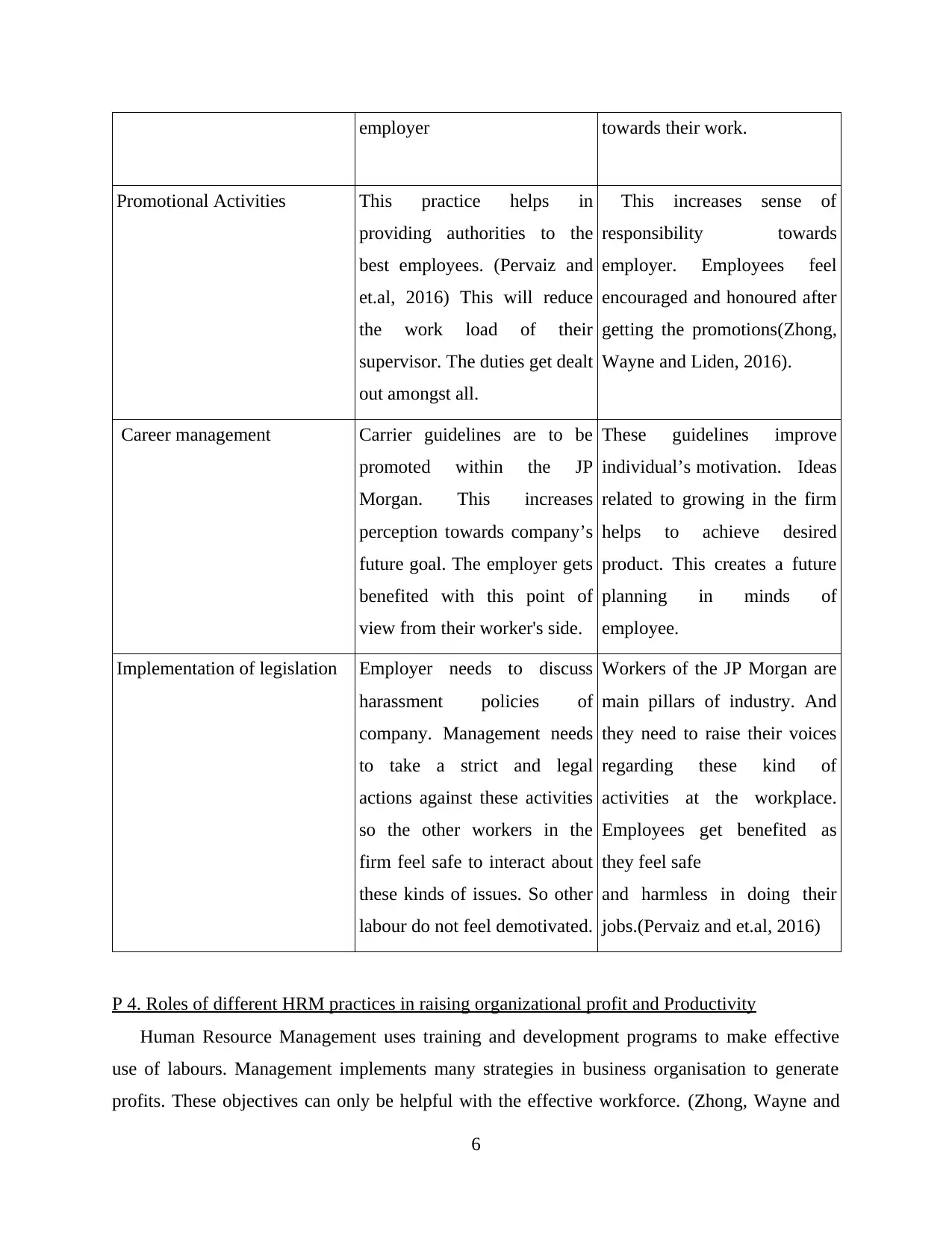
employer towards their work.
Promotional Activities This practice helps in
providing authorities to the
best employees. (Pervaiz and
et.al, 2016) This will reduce
the work load of their
supervisor. The duties get dealt
out amongst all.
This increases sense of
responsibility towards
employer. Employees feel
encouraged and honoured after
getting the promotions(Zhong,
Wayne and Liden, 2016).
Career management Carrier guidelines are to be
promoted within the JP
Morgan. This increases
perception towards company’s
future goal. The employer gets
benefited with this point of
view from their worker's side.
These guidelines improve
individual’s motivation. Ideas
related to growing in the firm
helps to achieve desired
product. This creates a future
planning in minds of
employee.
Implementation of legislation Employer needs to discuss
harassment policies of
company. Management needs
to take a strict and legal
actions against these activities
so the other workers in the
firm feel safe to interact about
these kinds of issues. So other
labour do not feel demotivated.
Workers of the JP Morgan are
main pillars of industry. And
they need to raise their voices
regarding these kind of
activities at the workplace.
Employees get benefited as
they feel safe
and harmless in doing their
jobs.(Pervaiz and et.al, 2016)
P 4. Roles of different HRM practices in raising organizational profit and Productivity
Human Resource Management uses training and development programs to make effective
use of labours. Management implements many strategies in business organisation to generate
profits. These objectives can only be helpful with the effective workforce. (Zhong, Wayne and
6
Promotional Activities This practice helps in
providing authorities to the
best employees. (Pervaiz and
et.al, 2016) This will reduce
the work load of their
supervisor. The duties get dealt
out amongst all.
This increases sense of
responsibility towards
employer. Employees feel
encouraged and honoured after
getting the promotions(Zhong,
Wayne and Liden, 2016).
Career management Carrier guidelines are to be
promoted within the JP
Morgan. This increases
perception towards company’s
future goal. The employer gets
benefited with this point of
view from their worker's side.
These guidelines improve
individual’s motivation. Ideas
related to growing in the firm
helps to achieve desired
product. This creates a future
planning in minds of
employee.
Implementation of legislation Employer needs to discuss
harassment policies of
company. Management needs
to take a strict and legal
actions against these activities
so the other workers in the
firm feel safe to interact about
these kinds of issues. So other
labour do not feel demotivated.
Workers of the JP Morgan are
main pillars of industry. And
they need to raise their voices
regarding these kind of
activities at the workplace.
Employees get benefited as
they feel safe
and harmless in doing their
jobs.(Pervaiz and et.al, 2016)
P 4. Roles of different HRM practices in raising organizational profit and Productivity
Human Resource Management uses training and development programs to make effective
use of labours. Management implements many strategies in business organisation to generate
profits. These objectives can only be helpful with the effective workforce. (Zhong, Wayne and
6
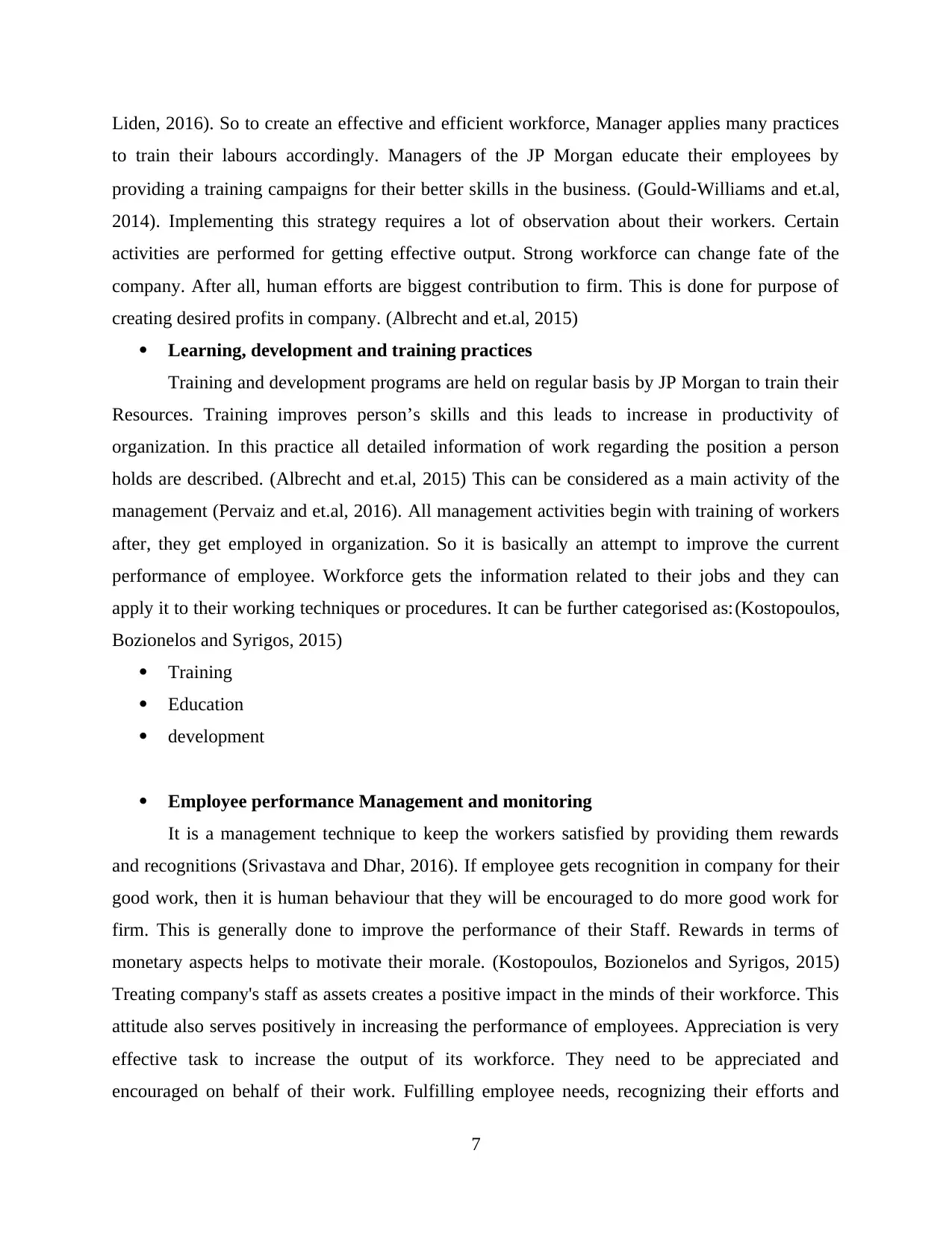
Liden, 2016). So to create an effective and efficient workforce, Manager applies many practices
to train their labours accordingly. Managers of the JP Morgan educate their employees by
providing a training campaigns for their better skills in the business. (Gould‐Williams and et.al,
2014). Implementing this strategy requires a lot of observation about their workers. Certain
activities are performed for getting effective output. Strong workforce can change fate of the
company. After all, human efforts are biggest contribution to firm. This is done for purpose of
creating desired profits in company. (Albrecht and et.al, 2015)
Learning, development and training practices
Training and development programs are held on regular basis by JP Morgan to train their
Resources. Training improves person’s skills and this leads to increase in productivity of
organization. In this practice all detailed information of work regarding the position a person
holds are described. (Albrecht and et.al, 2015) This can be considered as a main activity of the
management (Pervaiz and et.al, 2016). All management activities begin with training of workers
after, they get employed in organization. So it is basically an attempt to improve the current
performance of employee. Workforce gets the information related to their jobs and they can
apply it to their working techniques or procedures. It can be further categorised as:(Kostopoulos,
Bozionelos and Syrigos, 2015)
Training
Education
development
Employee performance Management and monitoring
It is a management technique to keep the workers satisfied by providing them rewards
and recognitions (Srivastava and Dhar, 2016). If employee gets recognition in company for their
good work, then it is human behaviour that they will be encouraged to do more good work for
firm. This is generally done to improve the performance of their Staff. Rewards in terms of
monetary aspects helps to motivate their morale. (Kostopoulos, Bozionelos and Syrigos, 2015)
Treating company's staff as assets creates a positive impact in the minds of their workforce. This
attitude also serves positively in increasing the performance of employees. Appreciation is very
effective task to increase the output of its workforce. They need to be appreciated and
encouraged on behalf of their work. Fulfilling employee needs, recognizing their efforts and
7
to train their labours accordingly. Managers of the JP Morgan educate their employees by
providing a training campaigns for their better skills in the business. (Gould‐Williams and et.al,
2014). Implementing this strategy requires a lot of observation about their workers. Certain
activities are performed for getting effective output. Strong workforce can change fate of the
company. After all, human efforts are biggest contribution to firm. This is done for purpose of
creating desired profits in company. (Albrecht and et.al, 2015)
Learning, development and training practices
Training and development programs are held on regular basis by JP Morgan to train their
Resources. Training improves person’s skills and this leads to increase in productivity of
organization. In this practice all detailed information of work regarding the position a person
holds are described. (Albrecht and et.al, 2015) This can be considered as a main activity of the
management (Pervaiz and et.al, 2016). All management activities begin with training of workers
after, they get employed in organization. So it is basically an attempt to improve the current
performance of employee. Workforce gets the information related to their jobs and they can
apply it to their working techniques or procedures. It can be further categorised as:(Kostopoulos,
Bozionelos and Syrigos, 2015)
Training
Education
development
Employee performance Management and monitoring
It is a management technique to keep the workers satisfied by providing them rewards
and recognitions (Srivastava and Dhar, 2016). If employee gets recognition in company for their
good work, then it is human behaviour that they will be encouraged to do more good work for
firm. This is generally done to improve the performance of their Staff. Rewards in terms of
monetary aspects helps to motivate their morale. (Kostopoulos, Bozionelos and Syrigos, 2015)
Treating company's staff as assets creates a positive impact in the minds of their workforce. This
attitude also serves positively in increasing the performance of employees. Appreciation is very
effective task to increase the output of its workforce. They need to be appreciated and
encouraged on behalf of their work. Fulfilling employee needs, recognizing their efforts and
7
⊘ This is a preview!⊘
Do you want full access?
Subscribe today to unlock all pages.

Trusted by 1+ million students worldwide
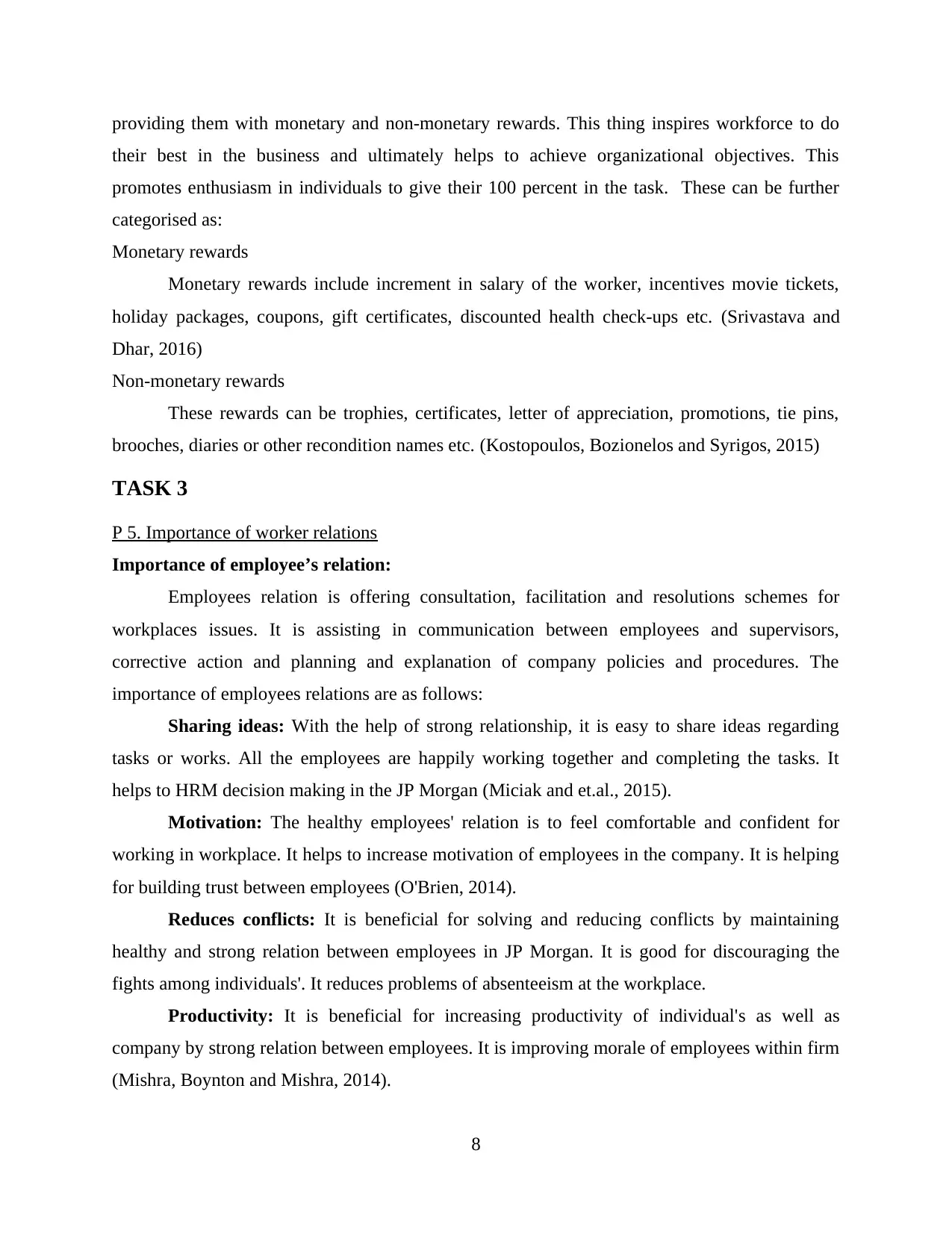
providing them with monetary and non-monetary rewards. This thing inspires workforce to do
their best in the business and ultimately helps to achieve organizational objectives. This
promotes enthusiasm in individuals to give their 100 percent in the task. These can be further
categorised as:
Monetary rewards
Monetary rewards include increment in salary of the worker, incentives movie tickets,
holiday packages, coupons, gift certificates, discounted health check-ups etc. (Srivastava and
Dhar, 2016)
Non-monetary rewards
These rewards can be trophies, certificates, letter of appreciation, promotions, tie pins,
brooches, diaries or other recondition names etc. (Kostopoulos, Bozionelos and Syrigos, 2015)
TASK 3
P 5. Importance of worker relations
Importance of employee’s relation:
Employees relation is offering consultation, facilitation and resolutions schemes for
workplaces issues. It is assisting in communication between employees and supervisors,
corrective action and planning and explanation of company policies and procedures. The
importance of employees relations are as follows:
Sharing ideas: With the help of strong relationship, it is easy to share ideas regarding
tasks or works. All the employees are happily working together and completing the tasks. It
helps to HRM decision making in the JP Morgan (Miciak and et.al., 2015).
Motivation: The healthy employees' relation is to feel comfortable and confident for
working in workplace. It helps to increase motivation of employees in the company. It is helping
for building trust between employees (O'Brien, 2014).
Reduces conflicts: It is beneficial for solving and reducing conflicts by maintaining
healthy and strong relation between employees in JP Morgan. It is good for discouraging the
fights among individuals'. It reduces problems of absenteeism at the workplace.
Productivity: It is beneficial for increasing productivity of individual's as well as
company by strong relation between employees. It is improving morale of employees within firm
(Mishra, Boynton and Mishra, 2014).
8
their best in the business and ultimately helps to achieve organizational objectives. This
promotes enthusiasm in individuals to give their 100 percent in the task. These can be further
categorised as:
Monetary rewards
Monetary rewards include increment in salary of the worker, incentives movie tickets,
holiday packages, coupons, gift certificates, discounted health check-ups etc. (Srivastava and
Dhar, 2016)
Non-monetary rewards
These rewards can be trophies, certificates, letter of appreciation, promotions, tie pins,
brooches, diaries or other recondition names etc. (Kostopoulos, Bozionelos and Syrigos, 2015)
TASK 3
P 5. Importance of worker relations
Importance of employee’s relation:
Employees relation is offering consultation, facilitation and resolutions schemes for
workplaces issues. It is assisting in communication between employees and supervisors,
corrective action and planning and explanation of company policies and procedures. The
importance of employees relations are as follows:
Sharing ideas: With the help of strong relationship, it is easy to share ideas regarding
tasks or works. All the employees are happily working together and completing the tasks. It
helps to HRM decision making in the JP Morgan (Miciak and et.al., 2015).
Motivation: The healthy employees' relation is to feel comfortable and confident for
working in workplace. It helps to increase motivation of employees in the company. It is helping
for building trust between employees (O'Brien, 2014).
Reduces conflicts: It is beneficial for solving and reducing conflicts by maintaining
healthy and strong relation between employees in JP Morgan. It is good for discouraging the
fights among individuals'. It reduces problems of absenteeism at the workplace.
Productivity: It is beneficial for increasing productivity of individual's as well as
company by strong relation between employees. It is improving morale of employees within firm
(Mishra, Boynton and Mishra, 2014).
8
Paraphrase This Document
Need a fresh take? Get an instant paraphrase of this document with our AI Paraphraser
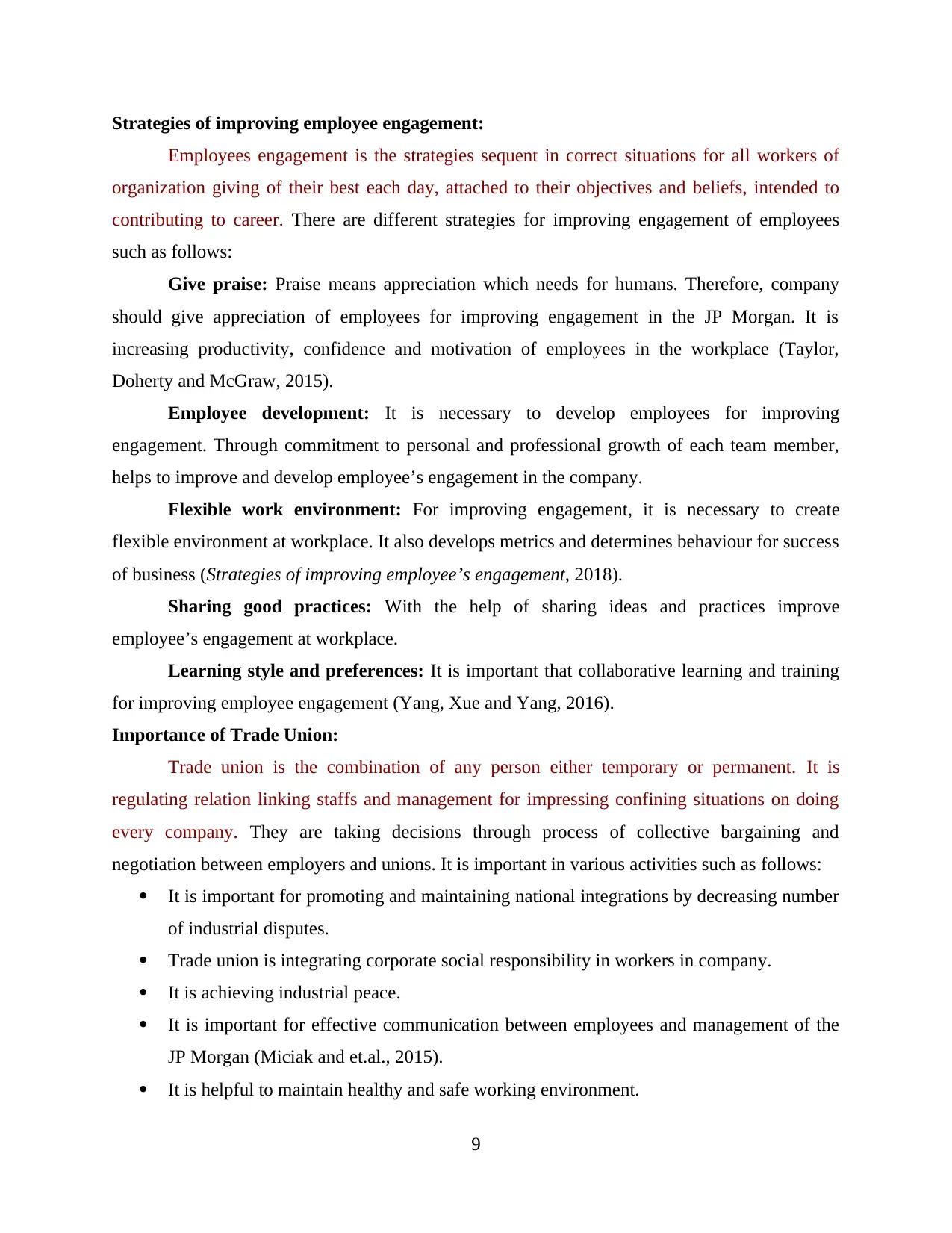
Strategies of improving employee engagement:
Employees engagement is the strategies sequent in correct situations for all workers of
organization giving of their best each day, attached to their objectives and beliefs, intended to
contributing to career. There are different strategies for improving engagement of employees
such as follows:
Give praise: Praise means appreciation which needs for humans. Therefore, company
should give appreciation of employees for improving engagement in the JP Morgan. It is
increasing productivity, confidence and motivation of employees in the workplace (Taylor,
Doherty and McGraw, 2015).
Employee development: It is necessary to develop employees for improving
engagement. Through commitment to personal and professional growth of each team member,
helps to improve and develop employee’s engagement in the company.
Flexible work environment: For improving engagement, it is necessary to create
flexible environment at workplace. It also develops metrics and determines behaviour for success
of business (Strategies of improving employee’s engagement, 2018).
Sharing good practices: With the help of sharing ideas and practices improve
employee’s engagement at workplace.
Learning style and preferences: It is important that collaborative learning and training
for improving employee engagement (Yang, Xue and Yang, 2016).
Importance of Trade Union:
Trade union is the combination of any person either temporary or permanent. It is
regulating relation linking staffs and management for impressing confining situations on doing
every company. They are taking decisions through process of collective bargaining and
negotiation between employers and unions. It is important in various activities such as follows:
It is important for promoting and maintaining national integrations by decreasing number
of industrial disputes.
Trade union is integrating corporate social responsibility in workers in company.
It is achieving industrial peace.
It is important for effective communication between employees and management of the
JP Morgan (Miciak and et.al., 2015).
It is helpful to maintain healthy and safe working environment.
9
Employees engagement is the strategies sequent in correct situations for all workers of
organization giving of their best each day, attached to their objectives and beliefs, intended to
contributing to career. There are different strategies for improving engagement of employees
such as follows:
Give praise: Praise means appreciation which needs for humans. Therefore, company
should give appreciation of employees for improving engagement in the JP Morgan. It is
increasing productivity, confidence and motivation of employees in the workplace (Taylor,
Doherty and McGraw, 2015).
Employee development: It is necessary to develop employees for improving
engagement. Through commitment to personal and professional growth of each team member,
helps to improve and develop employee’s engagement in the company.
Flexible work environment: For improving engagement, it is necessary to create
flexible environment at workplace. It also develops metrics and determines behaviour for success
of business (Strategies of improving employee’s engagement, 2018).
Sharing good practices: With the help of sharing ideas and practices improve
employee’s engagement at workplace.
Learning style and preferences: It is important that collaborative learning and training
for improving employee engagement (Yang, Xue and Yang, 2016).
Importance of Trade Union:
Trade union is the combination of any person either temporary or permanent. It is
regulating relation linking staffs and management for impressing confining situations on doing
every company. They are taking decisions through process of collective bargaining and
negotiation between employers and unions. It is important in various activities such as follows:
It is important for promoting and maintaining national integrations by decreasing number
of industrial disputes.
Trade union is integrating corporate social responsibility in workers in company.
It is achieving industrial peace.
It is important for effective communication between employees and management of the
JP Morgan (Miciak and et.al., 2015).
It is helpful to maintain healthy and safe working environment.
9

Trade unions provide advice and support to ensure that difference of opinions turns into
major conflicts.
It helps in the recruitment and selection of employees.
They are inculcating discipline among the workforces in organization.
It is helping to represent people at work and protecting their interest in the firm.
P 6. Key elements of employment legislation and its impact
Employment legislation is law that regulates employment within the workplace with
everyone who are working. This directly affects the employers, workers and unions. The role is
to identify who can and cannot be employed. They are offering job and treated during process of
engagement. With minimum terms and conditions under which they are working (Mishra,
Boynton and Mishra, 2014).
Health and Safety, 1974: It is primary piece of legislation which includes organizational
welfare and security in Britain. It determines important cognition and control for approval,
regulation and social control of work health, security and welfare with UK. Activity determines
on workers, employers, contractors, suppliers of goods, peoples in control of work premises.
This act is enable a wide plans of standards by authority’s minister through legal devices in since
1974. It is generating the large scheme of particular provisions for several companies' strictness
and hazards.
Activity gives an analytical program along with organised regulation on company welfare
and security (Taylor, Doherty and McGraw, 2015). The objectives of act are to secure well-
being, security as well as benefit of peoples in company, control the emergence into atmosphere
of harmful or offensive substance. Duties of employers is to ensure that laws of collection,
direction, preparation and management for health and safety in organization. The responsibility
of employees is to take care of well-being and refuge of employees as well as various humans
cooperating with employers. The primary provisions are including in HSW such as follows:
The responsibility for harmless procedure which are including care of company
atmosphere.
Safe usage involves management as well as keeping of unsafe and risky materials and
components.
Appropriate health and security preparation of employees.
Capable well-being conditions of employees in JP Morgan.
10
major conflicts.
It helps in the recruitment and selection of employees.
They are inculcating discipline among the workforces in organization.
It is helping to represent people at work and protecting their interest in the firm.
P 6. Key elements of employment legislation and its impact
Employment legislation is law that regulates employment within the workplace with
everyone who are working. This directly affects the employers, workers and unions. The role is
to identify who can and cannot be employed. They are offering job and treated during process of
engagement. With minimum terms and conditions under which they are working (Mishra,
Boynton and Mishra, 2014).
Health and Safety, 1974: It is primary piece of legislation which includes organizational
welfare and security in Britain. It determines important cognition and control for approval,
regulation and social control of work health, security and welfare with UK. Activity determines
on workers, employers, contractors, suppliers of goods, peoples in control of work premises.
This act is enable a wide plans of standards by authority’s minister through legal devices in since
1974. It is generating the large scheme of particular provisions for several companies' strictness
and hazards.
Activity gives an analytical program along with organised regulation on company welfare
and security (Taylor, Doherty and McGraw, 2015). The objectives of act are to secure well-
being, security as well as benefit of peoples in company, control the emergence into atmosphere
of harmful or offensive substance. Duties of employers is to ensure that laws of collection,
direction, preparation and management for health and safety in organization. The responsibility
of employees is to take care of well-being and refuge of employees as well as various humans
cooperating with employers. The primary provisions are including in HSW such as follows:
The responsibility for harmless procedure which are including care of company
atmosphere.
Safe usage involves management as well as keeping of unsafe and risky materials and
components.
Appropriate health and security preparation of employees.
Capable well-being conditions of employees in JP Morgan.
10
⊘ This is a preview!⊘
Do you want full access?
Subscribe today to unlock all pages.

Trusted by 1+ million students worldwide
1 out of 19
Related Documents
Your All-in-One AI-Powered Toolkit for Academic Success.
+13062052269
info@desklib.com
Available 24*7 on WhatsApp / Email
![[object Object]](/_next/static/media/star-bottom.7253800d.svg)
Unlock your academic potential
Copyright © 2020–2025 A2Z Services. All Rights Reserved. Developed and managed by ZUCOL.





